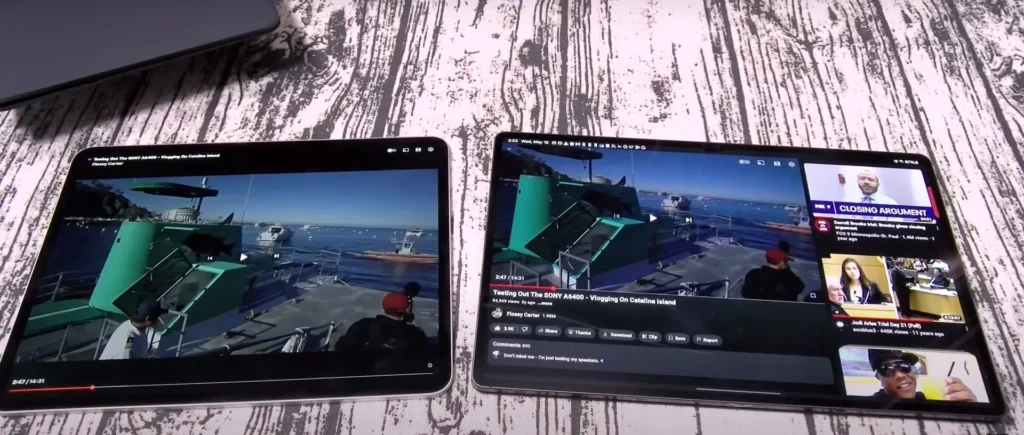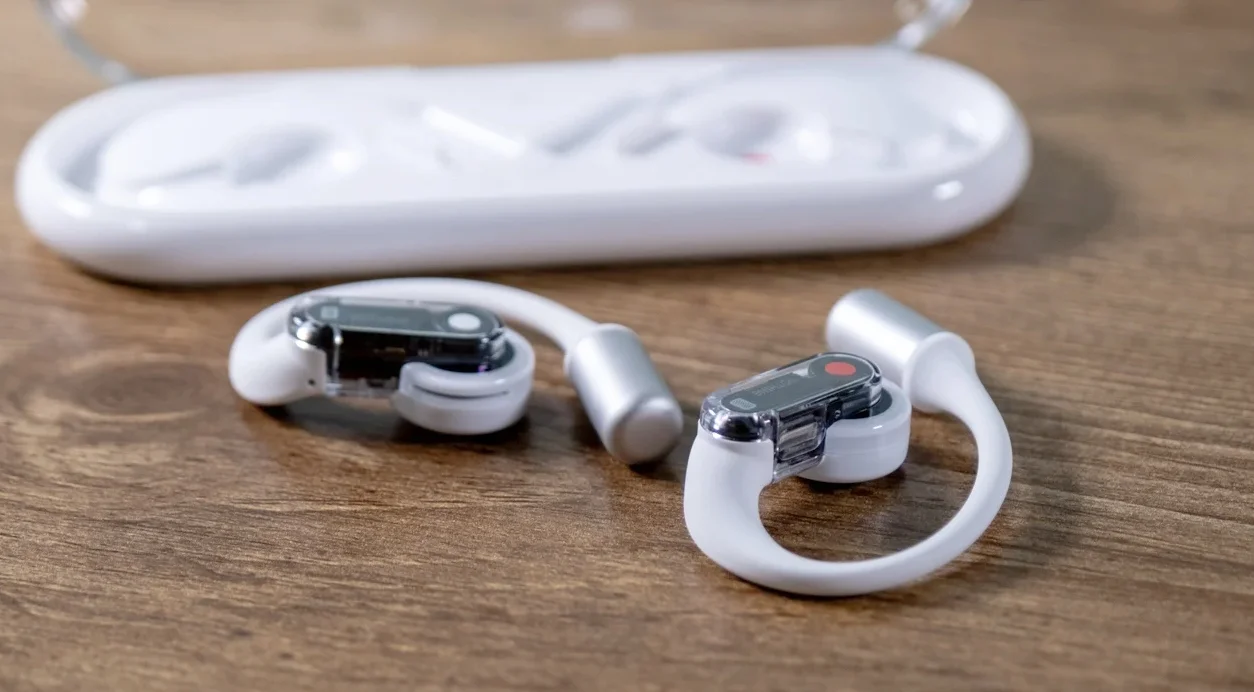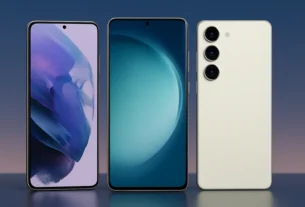The iPad Pro with the M4 chip not only feels faster, it’s a beast that, while it feels underutilized, will last you a long time.
Here I have in my hands the new iPad Pro with the M4 chip, none other than the 13-inch model, which, even for someone my size, is a giant tablet. It’s Apple’s best, most powerful, and brightest tablet, and after a year of drought, it’s the update we’ve been waiting for.
I’ve been testing this iPad Pro for the past two weeks, and for many days it has become not only my everyday tablet, but also my laptop and main screen for watching videos, series, and movies.
The new M4 chip, a substantial improvement over the M2 but still falling short of the M3 chip, is one of its best features, but there are other new features worth mentioning, such as the dual OLED screen and the fact that it is now thinner and lighter.
The model I’ve been testing is the 13-inch iPad Pro M4 with 2 TB of storage, a textured glass screen, and 5G. It’s the highest-end model, but for all practical purposes, it only differs from the cheapest model in size and screen type.
There’s a lot to talk about with this iPad Pro M4. Read on to find out everything you need to know and decide if it’s worth making the purchase of a lifetime.
An iPad that doesn’t need a design overhaul, with fast Wi-Fi and 5G

It’s not that the iPad was in desperate need of a redesign, honestly. It’s a product that is practically all screen, with the back covered by a case, so the only thing Apple could improve in terms of design is to trim the bezels.
However, not content with having two screen sizes, Apple has done the impossible to make the new 2024 iPad Pro thinner.
The 13-inch model is thinner because it has more space for a larger battery. But at 579 grams, it doesn’t feel heavy in your hand considering its large screen.
In terms of design, the position of the camera has also changed, moving from the top to the right side, which is much more comfortable for video calls when held horizontally.
It retains the two volume buttons and the power button, the magnetic pins (Smart Connector) for use with the Magic Keyboard, and a magnetic charging area for the new Apple Pencil Pro.
The most surprising thing about the iPad Pro’s design, especially on the 13-inch model, is how big the screen is and how light it feels in your hand. Apple has achieved something that is quite difficult: a tablet of this size that doesn’t feel like a burden.
Connectivity is quite comprehensive. It has Wi-Fi 6E, although I’m surprised that they don’t use Wi-Fi 7 at this point for such a “Pro” model. It also has Bluetooth 5.3 and GPS for the model with 5G connectivity.
Please note that this iPad Pro no longer has a SIM card tray; it has been switched 100% to eSIM.
The nanotextured glass screen is too special for an iPad
I bought an 11-inch iPad Pro in 2023 and couldn’t be happier with this tablet. But this time, the iPad Pro M4 I’m testing is not only bigger, at 13 inches, it’s also the model with nanotextured glass, and I definitely have some opinions.
Let’s start with the obvious. The screen is very bright, 1,000 nits maximum in normal mode and up to 1,600 nits when playing HDR content, which is insane for a tablet.
The detail of the screen is very interesting. Apple has included two OLED screens, one on top of the other, to combine the light and achieve those brightness levels. This makes it brighter, yes, but it also achieves incredible color reproduction.
The problem is that the nanotextured glass model has a permanent matte effect that creates a strange effect that you have to get used to and that, without a doubt, if you want to consume videos and photos with maximum detail, you should avoid.
This nanotextured glass is designed to minimize light reflections, and it does achieve this, but at the cost of a matte tone in all images. Personally, I don’t see this as a negative point; it gives it a different feel and, interestingly, it’s much better for reading than a screen with more reflections.
You don’t notice it much to the touch, but you can see the texture, which could resemble paper. Probably the closest thing to it is one of the Paperlike films that designers and illustrators often install on their iPads.
This iPad Pro, despite being thinner, still has four speakers which, despite having less space to move air, have a very high volume level, over 90%, with very little distortion. While it’s not the right speaker for playing music at a party, it can save you on more than one occasion.
The speaker volume is powerful enough that you can hear the conversation even in another room during calls. And the microphones, which are important for those calls, do a great job of picking up your voice even at a distance.
iPadOS does not take advantage of the power of the M4

This iPad Pro, especially the 13-inch model, is a laptop. And no one is going to change my mind on that. It may not be the laptop people expected from Apple, but it is, for all intents and purposes, a laptop replacement.
The combination of the M4 chip, the large screen, and a Magic Keyboard (or any keyboard case) makes it a laptop suitable for more people than you might think.
Yes, iPadOS is a different operating system, and although it’s getting closer, it’s still a long way behind what you can do with macOS. But putting macOS on an iPad Pro isn’t the solution; the solution is to have better PC apps adapted to an iPad.
So good that I don’t think there are many people who will take advantage of everything it has to offer in a product like the iPad Pro. In a MacBook Air or Pro? Definitely, but in an iPad, we’re still a long way off.
This chip doesn’t even break a sweat when performing tasks such as editing 50-megapixel RAW photos or exporting 4K video with DaVinci Resolve. It can handle any professional task you want, from video editing to photo editing to 3D modeling.
The M4 chip isn’t being used to its full potential on an iPad, which is a shame, because it could be the heart of a rocket that takes us to Mars, but we’re using it to watch videos on YouTube.
I said it before, and I still believe it. This iPad is a replacement for a laptop, but it’s not a replacement for macOS or Windows. That’s something else entirely. The reality is that most of us could do all the work we want to do on this tablet with the help of an external keyboard, such as the Magic Keyboard.
My work consists of using the browser, Safari on iPadOS, Slack, Telegram, some photo editing in Photomator and Pixelmator, video editing with DaVinci Resolve, answering emails with Gmail, and video calls with Zoom or Google Meet. Of course, I also write in Word or Google Docs and work with some Excel files.
I can do 100% of my work with this iPad. The problem? I’m so used to macOS and Windows that, for example, the limitation of open screens in a single window thanks to the visual organizer is a problem for me.
My trick to improve the experience is to go to Settings > Display & Brightness > Screen Zoom and activate “More Space” mode. As the name suggests, this gives you more space for windows. It reduces the resolution, but it’s a more portable mode.
I don’t think iPadOS is the problem at this point, it’s the apps we normally use.
They’ve removed the ultra-wide angle and you don’t even notice it

The iPad’s cameras are still more or less the same as the previous generation, except for one detail: the iPad Pro M4 no longer has an ultra-wide-angle camera, but has been left with a single 12-megapixel camera on the back.
Is it missed? Not at all. I can count on two hands the number of times I’ve opened the camera on an iPad, and I think all of them were to scan documents. The only camera that matters is the front camera, which, in addition to having Face ID face detection, is also ultra-wide angle.
The front camera has good image quality, even in poor lighting conditions. I took these shots in a room with very little light.
With an ultra-wide-angle lens, it can detect your face during video calls and follow you as you move, and when someone else enters the frame.
You Must Buy the Apple Pencil Pro and Magic Keyboard
As for iPad Pro accessories, I’ve received the two that you’re definitely going to hate having to buy because they’re expensive, but they’re great.
The new Apple Magic Keyboard for iPad Pro comes with some changes from the previous generation. The most important is that it is now made of aluminum in black or white. It is also lighter and, although it does not have more angle levels, it is one of the best typing experiences.
Apple Pencil Pro is Apple’s new stylus with important new features that are only interesting if you’re a digital artist who uses this iPad for your work. For people who often take notes, it’s too much of a stylus, but here’s the problem: this Pencil Pro is the only one compatible with this iPad that’s worth it. It also works with the Apple Pencil USB-C, but this one gives you more options.
I’ve noticed that compared to my Apple Pencil with my iPad Pro M2, the battery lasts less. After a couple of hours of use, the battery drops to around 20-25%, which didn’t happen with my other Apple Pencil.
It costs $149. Expensive? If you’re just going to write, yes, but if you’re an artist, it’s an essential tool.
The iPad’s big advantage is its longer battery life than a laptop (even with 5G).

This tablet’s battery life is the best I’ve seen on any tablet, even beating the iPad Pro M2 I use every day. It lasts longer than any laptop with the same usage. As a rule, I’ve managed to get two full days of work out of a single charge. That’s without 5G, though, even though this model is compatible.
The operating system is so well optimized with the help of its processor that the power consumption of normal tasks with its efficiency cores is… efficient.
The bad news is that it doesn’t include a charger in the box. Just a USB-C cable in the same color as the iPad.
The iPad Pro M4 is a good alternative, but there are better and cheaper options
The iPad Pro with M4 chip is Apple’s latest and best iPad. It’s a tablet for professionals that only makes sense to buy if you’re really going to use it professionally or, at least, for tasks that require so much performance that the M4 chip is the ideal choice.
It’s a real beauty of a tablet, more powerful than any laptop I currently have on my test bench, and I feel like I underutilize it in everything I do with it. It’s an iPad with performance that will outlive us all before it ever gives us any trouble, and that remains one of its great selling points: the iPad’s tremendous longevity and price-to-use ratio.
If you’re someone who uses your iPad for work, it’s an excellent choice, but beware of the nano-textured glass screen, because you’ll either love it or hate it. That said, I think 90% of people who work with an iPad can do the same job with an iPad Air.




